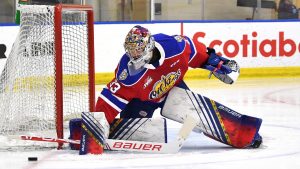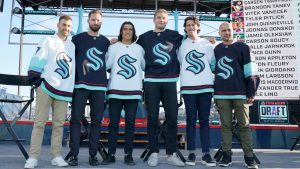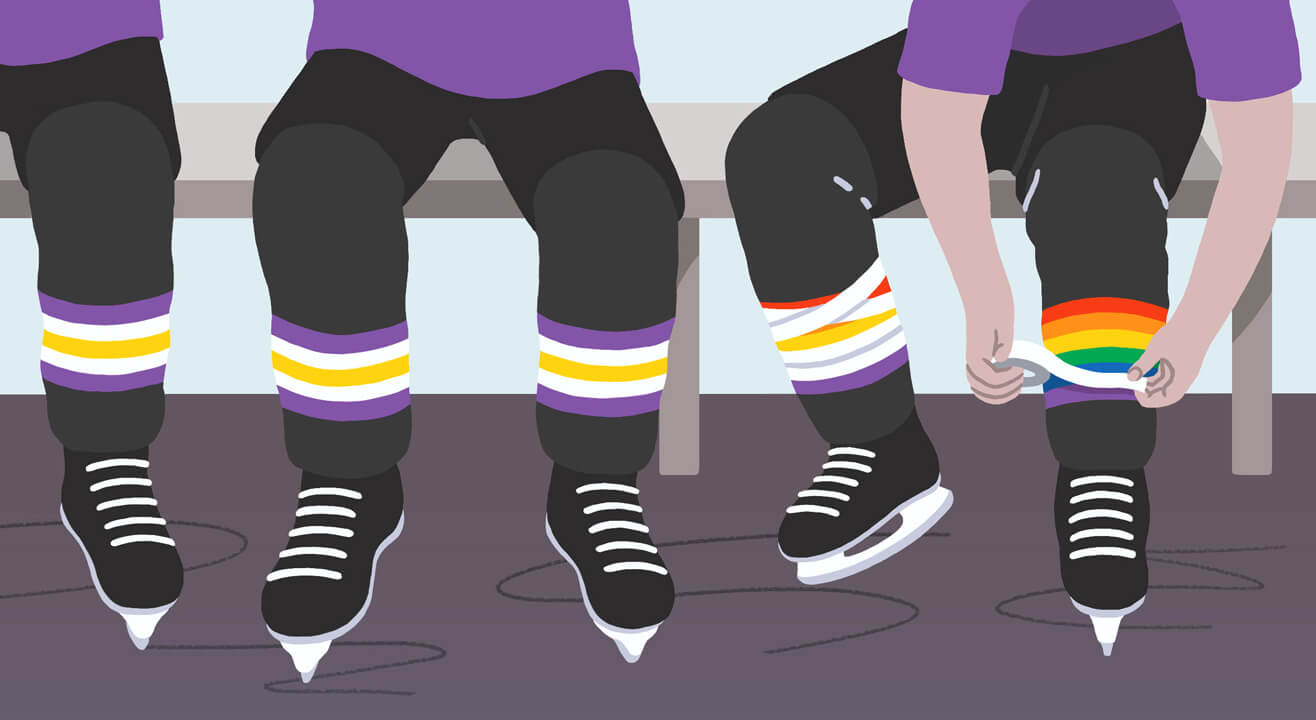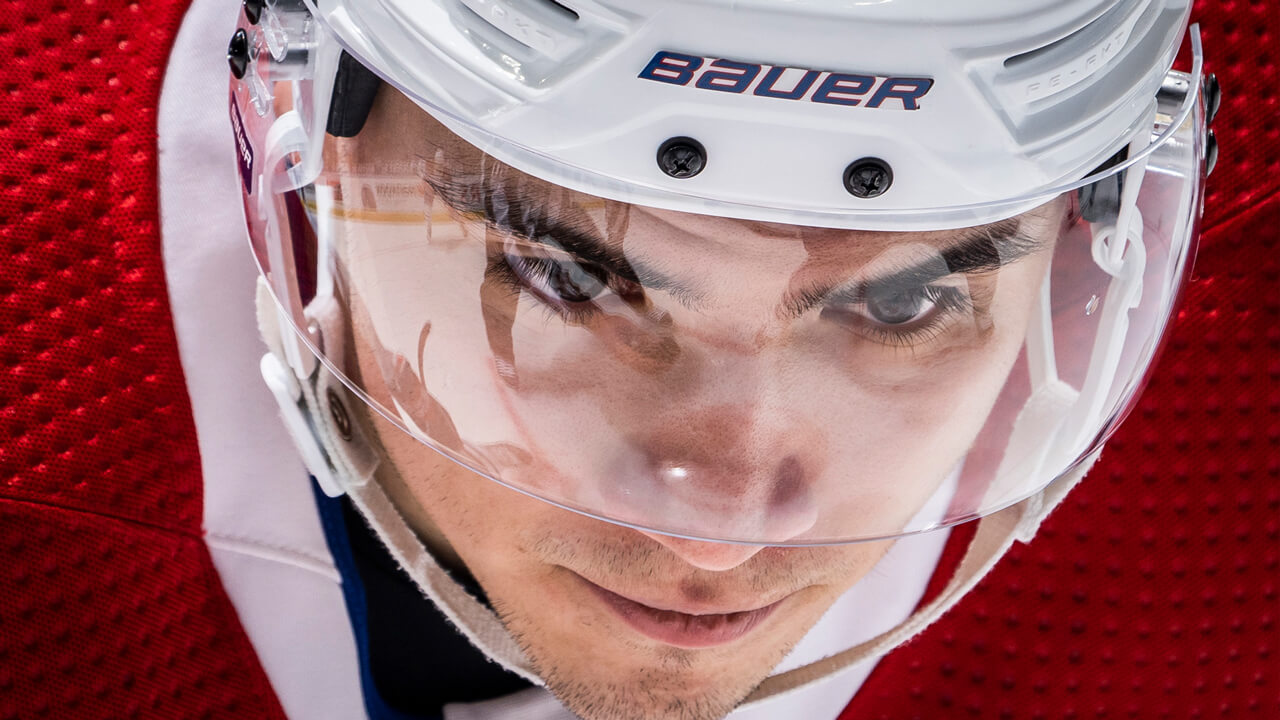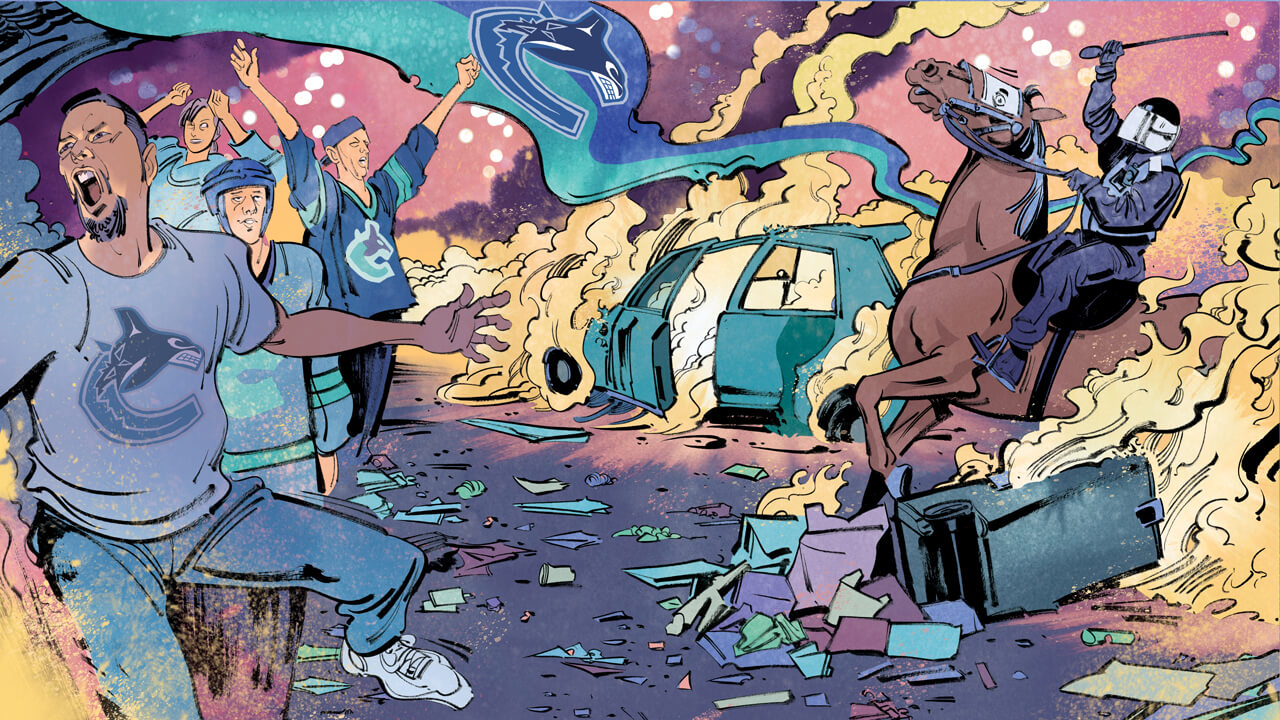The scouting director has questions he asks of every elite draft-eligible prospect who comes in for an interview. Some of the stuff he lobs at an 18-year-old in the draft-interview process is straightforward; some is meant to provoke or even goad, just to see how the player will respond, to get a sense of his character, his makeup. What the scouting director wanted this time, though, was a view of the player’s immediate expectations. Because the player here was Owen Power, NHL Central Scouting’s top-ranked North American skater, everyone else’s expectations are high. And because the director’s team has a lottery pick, management wasn’t looking just for help, but help now.
“Do you think you’re ready to play in the NHL next season?” the scouting director asked Power. “Do you see yourself playing in the league in the fall? What do you really want to do?”
The question isn’t much more than a hypothetical for most young defencemen. For defencemen like Power, the transition coming straight out of the draft and into the NHL is tougher than it is for forwards. The physical demands are more daunting. Mistakes are punished in plain sight.
Power, though, seems to be the rare draftee who could make the leap. He’s NHL-sized already, listed at six-foot-five and 230 pounds. He’s also a late birthday, so he’ll turn 19 early in the 2021–22 season, which matters since teams believe that there’s a big difference between 19 and 18 — or even 18 and a half. He spent last season with the University of Michigan and, though COVID disrupted the Wolverines’ schedule and limited it to 24 games, Power at least had an opportunity to skate against players in their early 20s. He certainly didn’t look overmatched or out of place in his 10 appearances for Canada at the world championships, playing 22 minutes per game in the elimination round with and against NHLers, and coming home with a gold medal as a souvenir. To some scouts, his performance at worlds sealed his ranking at the top of the 2021 class.
The scouting director and his staff were somewhat divided about Power’s readiness for the game’s highest level — some think he could step into the league in October, others believe a rush comes with risks. Not that they thought Power’s vote would be the tie-breaker, but they knew he could provide valuable insight on the matter — if a prospect doesn’t think he’s ready, better believe him. In this Zoom interview, the scouts didn’t exactly hear what they wanted to hear, at least if they were looking for a quick turnaround of their team’s fortunes. “I don’t know about playing in the league next season, but the one thing is that I don’t feel like I’ve really had the Yost experience yet,” Power told them.
The “Yost” Power mentioned is the Yost Ice Arena on the Michigan campus. While the NCAA plays a brand of hockey much like the CHL or other junior leagues, U.S. college hockey is somehow separate and distinct. Though it defies easy definition, the experience in the arena just feels different — it’s one thing to hear the cheers from the stands on Saturday but another to hear them from people who’ll sit next to you in class on Monday. Nowhere is that feeling more of a factor than in Ann Arbor. You could line up testimonials from this year’s team or from alumni, but there could be no better testament than Power’s answer to the scouting director. When fielding a question about the possibility of playing at the highest level of the professional game with millions in his bank account and 18,000 fans in attendance, he name-dropped a 98-year-old, 5,800-seat arena — an oversize brick bungalow built for the hoops team back when basketballs had laces. It would puzzle most who haven’t seen college hockey up close, and make perfect sense to anyone who’s ever skated for the Wolverines.

In any given year, one team might send forth a cluster of talked-about draft-eligible prospects. USA Hockey’s National Team Development Program (NTDP) dominated the 2019 draft, with centre Jack Hughes going first overall and six of his teammates selected in the top 15. That, though, is an aberration — most years you might see two prospects from the same team selected in the top 10. Barring some league-shaking megatrade, U of M will almost certainly be the story of the first hour of the draft on Friday night. Power is just one of three Wolverines freshmen in the top six North American skaters per the Central Scouting Service: He’s followed by centres Kent Johnson at No. 3 and Matthew Beniers at No. 6. There’s also a Michigan connection to another player likely to go in the top 10 in defenceman Luke Hughes, who’s ranked at No. 4 by CCS. Like his brothers Quinn and Jack before him, Hughes skated for USA Hockey’s under-18 program last season and, following Quinn’s lead, the youngest Hughes brother has committed to the University of Michigan for next season.
The three other freshmen players on this year’s Wolverines team have already been drafted: forwards Brendan Brisson and Thomas Bordeleau, and goaltender Erik Portillo. Brisson, the son of agent Pat Brisson, was selected by Vegas late in the first round last year. Bordeleau, son of former NHLer Sebastien Bordeleau, was selected by San Jose in the second round. Portillo played for Frolunda juniors in Sweden, and was selected by Buffalo in the third round in 2019.
This cluster of talent isn’t a recent or even an emerging phenomenon, but rather a self-perpetuating piece with history. “Michigan has had more players drafted than any other NCAA school,” says Red Berenson, the former NHLer who coached the Wolverines from 1984 to 2017 and now, at 81, serves as a special advisor to the school’s athletic director. “The fact is, in recruiting, talent attracts talent. The top young players see the success of the team and they see [Michigan players] getting drafted — they want to be a part of that. They also recognize that the University of Michigan offers them a chance to get a great education and to make contacts with people who can be important in their lives far beyond their playing careers.”
In that way, the Michigan hockey program isn’t a hockey hothouse along the lines of, say, the basketball team at the University of Kentucky, where elite pro prospects put in one season before going to the pros. “There’s no single formula for recruiting or development here,” Berenson says. “We’ve had players who’ve played one year before going to the NHL. Kyle Connor [of the Winnipeg Jets] led the country in scoring [with 35 goals and 71 points in 38 games] in his freshman year and moved on to the NHL. He became too good for NCAA hockey. We’ve had a bunch of players who stayed in school and got an education before going on to long NHL careers, like Mike Knuble, Brendan Morrison and Marty Turco.”
These players, Connor, Knuble et al, played for Berenson but when he retired from coaching, he handed over the whistle and clipboard to his long-time assistant, Mel Pearson. While history and the honour roll of distinguished player alumni are magnets for elite recruits, he acknowledges that the setting, the Ann Arbor campus, and the scene at the old arena, are key draws. “If Yost isn’t our greatest recruiting tool, it’s the one thing that makes the biggest impression on young players,” Pearson says. “A teenager who sits in the stands for a game and hears the crowd getting into it, the live band playing rather than the piped-in music you get in the pros, the cheers and chants, the banners … that stays with the kid. Anyone wants to be a part of it.”
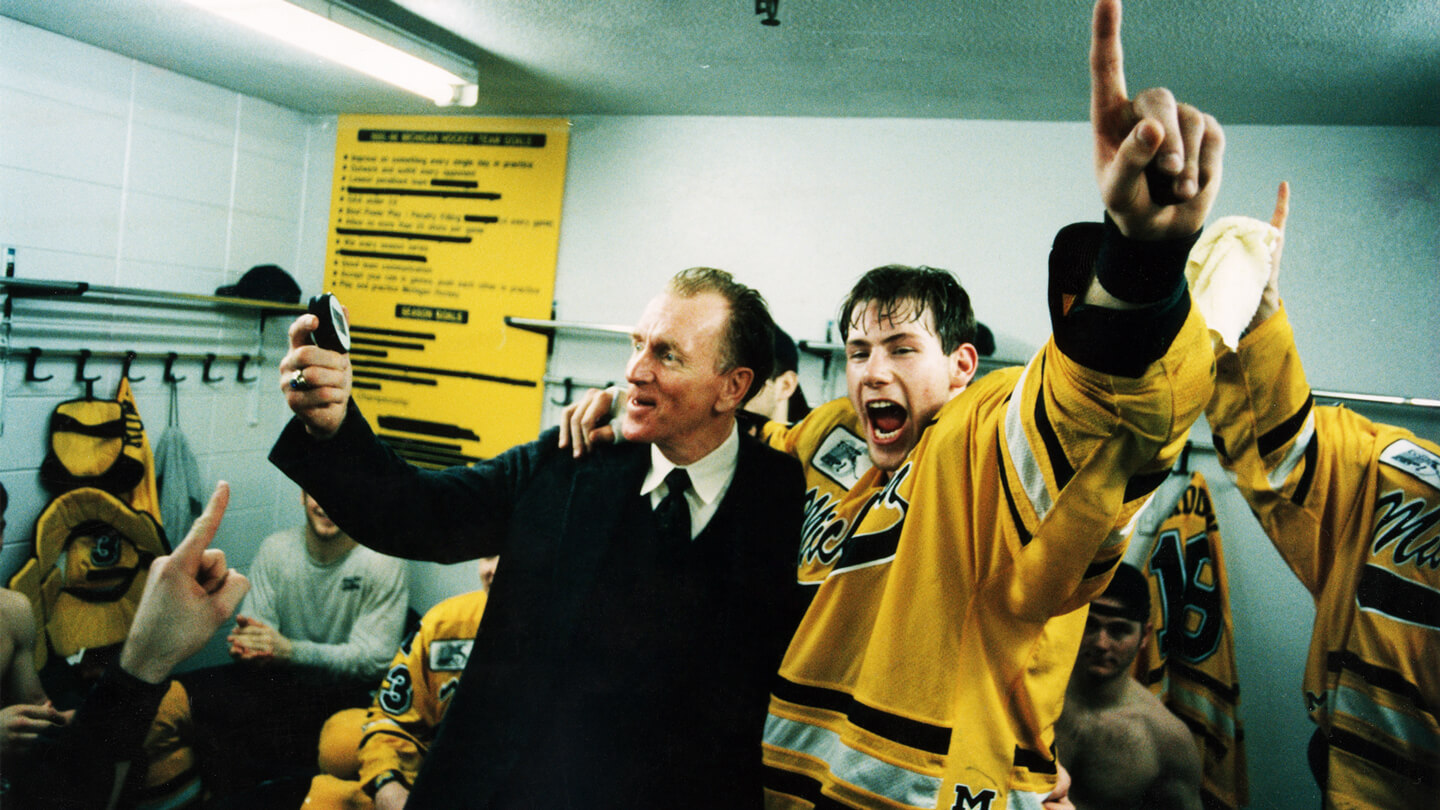
In a key way, geography sets the Yost Ice Arena apart from other hallowed NCAA venues — even the Big House, the 107,601-seat football field on Michigan’s campus. The Wolverines’ home is situated in the game’s American hotbed — apologies to Minnesota and the greater Boston area, but there’s more hockey history and more meaningful hockey played within a 100-mile radius of Ann Arbor than anywhere else in the U.S. It goes from the NHL to the AHL, from the USHL to the CHL. “Every team in the league has someone based here,” says one NHL amateur who resides right in Ann Arbor: “It’s like all the top kids are coming to you rather than you having to go somewhere to see them.”
The latest addition to the regional hockey scene might be the most important one with regard to the University of Michigan program. Not quite 20 years ago, USA Hockey founded its National Team Development Program right in Ann Arbor, bringing in the nation’s best under-18s basically into the Wolverines’ zip code. A few years back, the NTDP moved down the road from a surprisingly spartan set-up at a multi-pad arena in Ann Arbor to Plymouth, a very comfortable Detroit suburb where they now have a fully fitted facility. And the upgrade seems to have boosted the development of talent — witness that Jack Hughes–led draft class of 2019.
Rival NCAA recruiters will claim that having the NTDP in the Wolverines’ backyard gives them the inside track on those who’ve come through the under-17 and under-18 program. The sour grapes are understandable, but Pearson suggests that U of M’s advantage is overstated. “The kids from Minnesota and Wisconsin in the under-18 program tend to go to schools back close to home, and the same for the kids from New England,” he says. “And really, there are only so many scholarships we can offer in one year. It’s not like everyone [on the NTDP roster] can come over. USA Hockey will bring the players out to a game but it’s not an advertisement for the Michigan program but really for NCAA hockey.”
Unlike several others in his class, Power didn’t arrive via the NTDP. He’s a Mississauga, Ont., kid who skated for the Chicago Steel in the USHL for a couple of years. Still, he had a chance to see U of M when the Steel came in to play USA Hockey’s age-group outfits. His arrival on the campus in Ann Arbor is one of those cases of talent attracting talent.
Power opted to go the NCAA route, and to Michigan specifically, as a way to play with elite prospects and against more mature players than he’d face in the junior ranks. Fact is, if he had opted to play in the OHL this year he wouldn’t have played any games at all because of the pandemic shutdown. To a degree, the combination of the campus setting and COVID lockdowns has helped to insulate (or even socially distance) him from the pressures, sometimes all-consuming, that prospective first-overall selections face in the run-up to the NHL entry draft. Power suggests that’s equally true for Johnson and Berniers. “For all three of us, we don’t really talk about [the draft] that much,” Power told the Detroit Free Press this spring. “We go to the rink, and at the rink, no one really cares where you’re ranked really or what’s going on.”
Yost might not have been the happening place it has been in other seasons, and will be again next winter, but over the course of this last school year, the mostly quiet arena provided Power a chance to work on his game and a refuge from the buzz. And while most of the seats were empty, some were occupied by NHL scouts — another case of the talent coming to the NHL evaluators based in and around Ann Arbor. Says the scouting director who interviewed Power: “I got to see him a few times [at Yost Ice Arena], and seeing him live gives you a better appreciation of what he can do than any highlights you’d see on video.”

Never say never, but the chances of Power becoming one of those four-year players in Ann Arbor could only be viewed by the highest-powered microscope in the U of M labs. That said, it might not be a long shot that he’ll be back on campus this fall. It might turn out that his development is best served by another season of work before entering the NHL — if there’s any doubt, consider the struggles of recent first-overalls who leapt into the professional mix, e.g. Nico Hischier, Jack Hughes and Alexis Lafreniere. Patient approaches with collegiate defencemen or those heading to the NCAA seems to be paying off. A sophomore season at Michigan sent Quinn Hughes to the Canucks fully prepared to contribute immediately on the blueline. A year of college hockey made the transition to the Avs easier for Cale Makar.
Yet it wasn’t “development” that Power mentioned when asked about the upcoming season —it was “the Yost experience.” It’s jarring, not what we’ve been conditioned to expect, but understandable in context. NHL prospects weren’t just teenagers once; they’re still teenagers, even when they’re just weeks away from the league. While many players are consumed by the idea of “playing up” and “development for the pros,” they also put value in something as old-fashioned as “excitement” or “fun.” Says Mel Pearson: “I understand what Owen was saying about it. COVID hurt a lot of people and disrupted the hockey season. A lot of players didn’t get to play at all. We were lucky at Michigan to at least get in a reduced season and tournament play. But we couldn’t play at Yost at capacity or against other teams in their home rinks.”
Over the last 18 months or so, life in arenas and elsewhere has been turned inside out. It’s refreshing that an 18-year-old can be sentimental about his hockey career rather than mercenary, that he can love the game and the arena it’s played in more than the business built around it. Maybe not just refreshing, but necessary.

